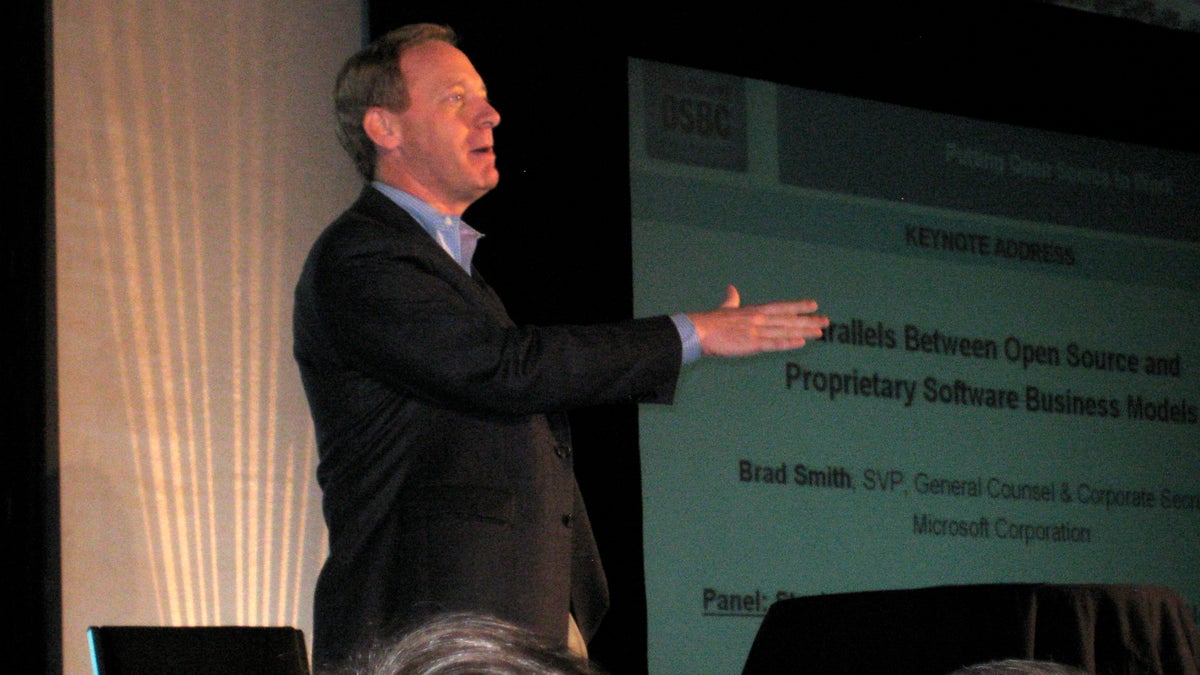OSBC Report: Microsoft attempts to cross the chasm to open source
Microsoft has made great strides, but it's nowhere near done.

Tonight Brad Smith, general counsel for Microsoft, delivered the "footnote" address at the Open Source Business Conference 2008. I asked Brad to speak because I figured it was the shortest path to getting clarity from Microsoft vis-a-vis open source and the nettlesome legal issues that have plagued Microsoft's relationship with open source.
Brad spoke for 30 minutes, and then participated in a follow-up panel with an A-list group from the open-source community, including Mark Shuttleworth (Ubuntu), James Bottomley (CTO, SteelEye and Linux kernel maintainer), Andrew Updegrove (standards lawyer extraordinaire), and Stephen O'Grady (Redmonk co-founder). The audience then had the opportunity to ask him questions for another 30 minutes. It was no doubt a grueling "opportunity" for Brad, and he represented himself and Microsoft well. (See also Charles Cooper's report.)
But it didn't result in any great "Ah ha!" moment, unfortunately. There are serious chasms between Microsoft's position(s) and the open-source community's position(s). It's very possible that both sides will have to compromise. What would compromise entail?
Brad talked around this in his opening remarks:
We respect and appreciate the important role that open source plays in our industry. We respect and appreciate the important role that open source plays for our customers, customers who almost always have heterogeneous networks. That's not what you've always heard from us, but I did want to start with this....
It is a big world, and it is a diverse world....We dreamed of a diversity in computing devices, and today we have them....Business models have also become more diverse. It is hard for us to discuss where the industry might go without taking into account the diverse business models that we have.
We really have three fundamental business models in the industry today:
- Direct monetization. We invest money, we hire engineers, we develop products, we sell licenses to that software. But this was not the first business model for software. That first model was indirect monetization.
- Indirect monetization. In the early days of computing the mainframe companies gave software away in order to sell their hardware. Microsoft uses this model fairly routinely.
- Ad-funded monetization.
We've evolved to an industry that has these three models, and we can't really predict where things go from here, though I would venture to guess that we'll continue to see diverse models for monetizing software....
The interesting thing to me in these different business models is how much good we as an industry have done for the world. How much more could we do if we find new ways to collaborate across the borders that divide us?...
If you look at the history of our industry, the market leader has never been the primary driver of interoperability. We've been on both sides of this. Interoperability has become a major trend in software today, and it's being driven by customers. Customers want software to work together....
(With interoperability in mind...) we're trying to find a way to balance our belief that some of our innovation should be kept proprietary while still working together with the open-source community, commercial or otherwise. This is an ongoing process that needs dialogue. We do want to make strides forward, but it requires dialogue.
We need to a have a direct conversation about hard issues, with patents being among the hardest. We all believe in the magic of software. We can find bridges between us.
All well and good. Brad is a fantastic speaker and an earnest, good person. What came out in the Q&A period was just how wide is the chasm between Microsoft and the open-source community on how to "cross-license" intellectual property.
Brad indicated that "We believe that patents spur innovation." So, Microsoft benefits from patents. Balanced against this, however, he also stressed that Microsoft is the recipient of more patent lawsuits than any other software company. It's therefore unclear to me why Microsoft would want to perpetuate a system that is inimical to its own interests. Why take a stance against open source that looks similar to the adverse relationships it has with patent litigants against Microsoft?
James pointed out that patents are particularly troublesome for open source because open-source licenses are effectively promises to downstream users that they have rights to use the software. Even Microsoft's patent licensing, no matter how small the fee (calling to mind Brad's comments that Microsoft will make its IP available at a very low price), is incompatible with open-source licensing.
Brad didn't have a good answer to this other than, "There's no easy answer to this problem." I don't fault him for this. There really is no easy solution.
In the audience Q&A session, Larry Rosen suggested that Microsoft could license its patents to the market and it would hardly make a dent in the company's overall revenue. Patent licensing can't really be about money, he went on to say, but must be about trying to restrict distribution of open-source software.
Brad responded that "What gives me pause is the premise that...Microsoft should make its intellectual property expensive or free, but not cheap." He may have a point--there doesn't seem to be much middle ground. But I do wonder if the middle ground that Microsoft is proposing is actually closer to its home territory than open source's.
There is no easy answer to this. It feels to me that Microsoft is struggling to listen and to heed the counsel it's being given by the open-source community, but has a long, hard road to go (which won't be comforting to it given how much it's already slogged through).